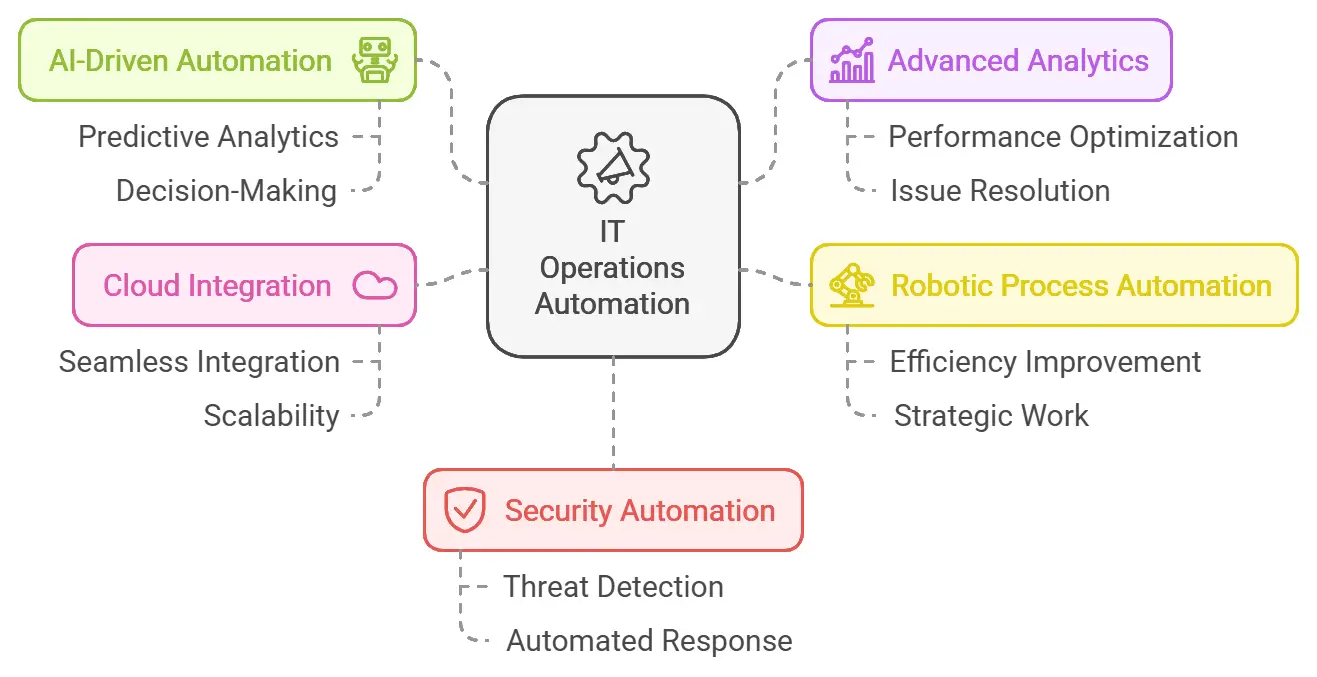Implementing and maintaining manual IT processes is inefficient and costly. Businesses spend about 75% of their IT budget maintaining outdated technology, diverting resources from innovation.
Charles Bender, CEO of Attentus Technologies, puts it this way. “Automation isn’t just about saving time; it’s about enabling businesses to focus on growth and innovation.”
IT process automation solves operational delays, repetitive tasks, or rising IT costs. By automating routine processes, you can eliminate inefficiencies, reduce costs, and enhance productivity across your IT systems.
In this blog, we’ll explore the importance of IT process automation, how it solves real-time problems, and the best tools to get started.
Transform Your IT Operations with Tailored Automation SolutionsEmpower your business with cutting-edge IT process automation strategies customized to your unique needs. |
Why IT Process Automation Matters for Efficiency
Automating your IT workflows creates opportunities for significant time and cost savings. With the right tools and strategies, you can eliminate redundancies and focus on driving innovation.
- Reduced Operational Costs: Automating repetitive tasks lets your IT team focus on strategic initiatives. This lowers overhead while increasing ROI. For example, a McKinsey study found that companies adopting automation can cut operational costs by up to 30% within five years.
- Improved Accuracy: Automated systems perform tasks consistently without errors. This minimizes risks and enhances system reliability, particularly in critical operations like data backups.
- Time Savings: Tasks that once took hours can now be completed in minutes or even seconds. This speeds up your overall business operations, allowing faster service delivery.
IT Operations Automation and Real-Time Problem Solving
Automation tools are crucial in maintaining efficient IT operations by detecting and resolving issues before they escalate.
Here’s how:
1. Proactive Monitoring.
Automated systems constantly monitor network performance, identifying vulnerabilities, anomalies, or downtime risks. This continuous surveillance ensures that systems remain stable and secure.
By catching potential issues early, businesses can avoid costly disruptions and maintain high service levels.
2. Automated Alerts
Instead of waiting for an issue to cause downtime, automation tools send instant notifications to IT staff when irregularities are detected.
These alerts provide detailed information about the nature and location of the problem, enabling quick, targeted responses. With this, you can minimize the impact of IT issues and maintain operational efficiency.
3. Self-Healing Systems
Advanced automation tools can detect problems and initiate corrective actions automatically. For instance, they can restart services, apply patches, or reroute traffic without human intervention. This capability further enhances system resilience and uptime.
With IT operations automation, your team can avoid potential disruptions, ensuring seamless business continuity.
Choosing the Right IT Process Automation Tools
Not all tools are created equal. Selecting the right IT process automation tools ensures your business gets the best results. Key considerations include:
- Scalability: Choose tools that grow with your business, accommodating increasing workloads and complexities. A scalable tool allows for seamless expansion and prevents bottlenecks as your needs evolve.
- Integration Capabilities: Ensure compatibility with your existing systems to avoid disruptions. The best automation tools integrate smoothly with current software, hardware, and processes, enhancing rather than hindering your operations.
- User-Friendliness: The tool should be intuitive, reducing the learning curve for your IT team. An easy-to-use interface ensures that your team can quickly adopt and utilize the tool effectively, leading to faster implementation and higher productivity.
- Security Features: Prioritize tools that offer robust security measures to protect sensitive data and ensure compliance with industry regulations. Strong security features are essential for safeguarding your business against cyber threats.
- Support and Training: Opt for providers that offer comprehensive support and training resources. Access to reliable customer support and thorough training materials helps your team make the most of the automation tool, ensuring smooth adoption and ongoing success.
Considering these factors, you can select the right IT process automation tools to enhance your business operations and drive efficiency.
Steps to Successful IT Process Automation
Implementing IT process automation effectively involves following a clear roadmap. Here are the steps:
- Identify Repetitive Tasks: Audit your IT processes to pinpoint tasks that consume the most time and resources.
- Select the Right Tools: Opt for tools tailored to your business needs. Consider scalability and compatibility.
- Train Your Team: Equip your team with the knowledge to utilize automation tools effectively.
- Measure Performance: Regularly evaluate the impact of automation on your IT operations.
- Iterate and Improve: Adjust your automation strategy as your business grows and technology evolves.
| More articles you might like |
Avoiding Common Pitfalls in IT Operations Automation
While automation offers immense benefits, improper implementation can lead to setbacks. Avoid these mistakes:
1. Over-Automation
Automating every process can cause inefficiencies and reduce flexibility. Focus on high-impact areas where automation can deliver the most value, such as repetitive tasks or processes that require quick responses.
Balancing automation with human oversight ensures optimal performance and adaptability.
2. Ignoring Employee Training:
Your team must understand and adapt to automation tools for successful implementation. Provide comprehensive training to ensure employees are comfortable with the new systems and can effectively manage and troubleshoot them.
A well-trained team maximizes the potential of automation. Companies with robust training programs achieve 218% higher income per employee.
3. Lack of Monitoring
Automation doesn’t mean set-and-forget. Continuous monitoring is essential to ensure systems operate smoothly and to detect any issues early.
Regular reviews and adjustments based on performance data help maintain efficiency and prevent problems from escalating.
4. Neglecting Security
Automated systems can be vulnerable to cyber threats if not properly secured. Ensure that robust security measures, such as encryption, firewalls, and regular updates, are in place to protect your automated operations from potential breaches.
When you avoid these common pitfalls, you can leverage IT operations automation to its fullest potential, ensuring long-term success and business continuity.
The Future of IT Operations Automation in Business

As automation evolves rapidly, several emerging trends are transforming IT operations. Here are the key ones:
- AI-Driven Automation: Artificial intelligence enhances predictive analytics and decision-making in IT operations, offering smarter, more efficient solutions.
- Advanced Analytics: Real-time data insights allow businesses to make informed decisions, optimize performance, and swiftly address issues.
- Robotic Process Automation (RPA): RPA further reduces manual tasks, enabling greater efficiency and freeing up employees for more strategic work.
- Cloud Integration: Seamless integration with cloud platforms enables scalable and flexible automation solutions.
- Security Automation: Enhancing cybersecurity measures through automated threat detection and response.
Embracing these trends ensures your business stays competitive in a tech-driven world, continuously improving efficiency and effectiveness.
How IT Process Automation Empowers IT Teams
Empowered IT teams drive business success. Here are key ways automation supports them:
- Enhanced Focus on Strategy: By automating mundane tasks, IT staff can concentrate on innovation and strategic planning.
- Improved Collaboration: Automation tools centralize data and processes, fostering better communication within teams.
- Reduced Stress: Fewer repetitive tasks mean less burnout, leading to higher job satisfaction and productivity.
Comparing IT Process Automation Tools
Choosing the right automation tool is crucial for seamless IT operations and sustained growth. The table below highlights top IT process automation tools, their unique strengths, and pricing models to help you make an informed decision.
| Tool Name | Best For | Key Features | Pricing Model |
| ServiceNow | IT Service Management | Workflow automation, ticketing | Subscription-based |
| Ansible | Configuration Management | Open-source, simple scripting | Free and enterprise plans |
| Zapier | App Integration | User-friendly, connects 5,000+ apps | Tiered subscription plans |
| Puppet | Infrastructure Automation | Supports hybrid cloud environments | Subscription-based |
| UiPath | Robotic Process Automation (RPA) | Visual automation designer, AI tools | Custom pricing |
Transform Your IT Workflow Today with Tailored Automation Solutions from Attentus Technologies
IT process automation is a proven strategy for business optimization. You can transform your IT operations by automating repetitive tasks, integrating advanced tools, and focusing on proactive management.
| Discover Our IT Consulting Services Around You: | ||
|---|---|---|
| Seattle | Bellevue | Tacoma |
| Renton | Federal Way | Kirkland |
| Everett | ||
With over 20 years of experience, Attentus Technologies is committed to being easy to work with—one of our core values. We provide tailored automation solutions designed to streamline your I.T. processes and help you achieve your business goals while offering customized pricing, so you only pay for the services your business truly needs.
Our I.T. consulting services boast a proven track record of reducing client I.T. issues over time through proactive strategies and expert guidance. Contact us today to schedule a consultation.

